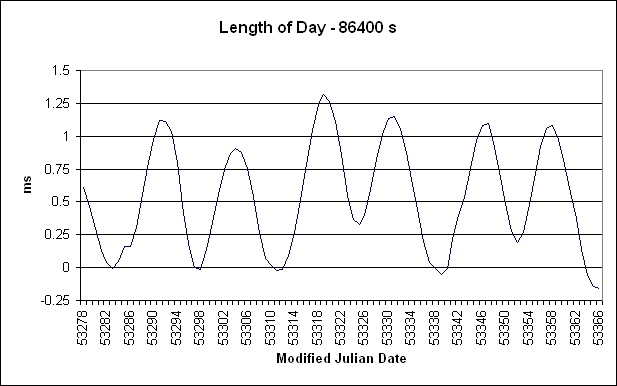
"Now let me see," the Golux said. "If you can touch the clocks and never
start them, then you can start the clocks and never touch them. That's
logic, as I know and use it...."
-- James Thurber, "The 13 Clocks"
- Atomic Time , with the unit of duration the Systeme International (SI) second defined as the duration of 9,192,631,770 cycles of radiation
corresponding to the transition between two hyperfine levels of the ground
state of cesium 133. TAI is the International Atomic Time scale, a
statistical timescale based on a large number of atomic clocks.
- Universal Time (UT) is counted from 0 hours at midnight, with
unit of duration the mean solar day, defined to be as uniform as possible
despite variations in the rotation of the Earth.
- UT0 is the rotational time of a particular place of observation.
It is observed as the diurnal motion of stars or extraterrestrial radio sources.
- UT1 is computed by correcting UT0 for the effect of
polar motion on the longitude of the observing site. It varies from
uniformity because of the
irregularities in the Earth's rotation.
- Coordinated Universal Time (UTC) differs from TAI by an integral
number of seconds. UTC is kept within 0.9 seconds of UT1 by the introduction
of one-second steps to UTC, the
"leap second."
To date these steps have always been positive.
- Dynamical Time replaced ephemeris time as the independent
argument in dynamical theories and ephemerides. Its unit of duration is based
on the orbital motions of the Earth, Moon, and planets.
- Terrestrial Time (TT), (or Terrestrial Dynamical Time, TDT), with unit of duration 86400 SI
seconds on the geoid, is the independent argument of apparent geocentric
ephemerides. TDT = TAI + 32.184 seconds.
- Barycentric Dynamical Time (TDB), is the independent argument of
ephemerides and dynamical theories that are referred to the solar system
barycenter. TDB varies from TT only by periodic variations.
- Geocentric Coordinate Time (TCG) is a coordinate time having
its spatial origin at the center of mass of the Earth. TCG differs from TT as:
TCG - TT = Lg x (JD -2443144.5) x 86400 seconds, with Lg = 6.969291e-10.
- Barycentric Coordinate Time (TCB)is a coordinate time having
its spatial origin at the solar system barycenter. TCB differs from TDB in rate.
The two are related by: TCB - TDB = iLb x (JD -2443144.5) x 86400 seconds, with
Lb = 1.550505e-08.
- Sidereal Time, with unit of duration the period of the Earth's
rotation with respect to a point nearly fixed with respect to the stars, is
the hour angle of the vernal equinox.
Delta T is the difference between Earth rotational time (UT1) and dynamical
time (TDT).
Predicted values of UT1 - UTC
are provided by the Earth Orientation Department. An example showing the variation of the length of the day in late 2004 is shown below. Units are milliseconds.

Julian Day Number is a count of days elapsed since Greenwich mean noon
on 1 January 4713 B.C., Julian proleptic calendar. The Julian Date is
the Julian day number followed by the fraction of the day elapsed since the preceding noon.
 We frequently make use of the
Modified Julian Date (MJD), which is
defined as MJD = JD - 2400000.5. An MJD day thus begins at midnight, civil
date. Julian dates can be expressed in UT , TAI, TDT, etc. and so for precise
applications the timescale should be specified, e.g. MJD 49135.3824 TAI.
We frequently make use of the
Modified Julian Date (MJD), which is
defined as MJD = JD - 2400000.5. An MJD day thus begins at midnight, civil
date. Julian dates can be expressed in UT , TAI, TDT, etc. and so for precise
applications the timescale should be specified, e.g. MJD 49135.3824 TAI.
For more information, see:
Explanatory Supplement to the Astronomical
Almanac, P. K. Seidelmann, ed., University Science Books, 1992, ISBN 0-935702-68-7
Back to Time Service Home Page
Dr. Demetrios Matsakis, Director, Time Service Dept., Matsakis.Demetrios@usno.navy.mil)



 We frequently make use of the
Modified Julian Date (MJD), which is
defined as MJD = JD - 2400000.5. An MJD day thus begins at midnight, civil
date. Julian dates can be expressed in UT , TAI, TDT, etc. and so for precise
applications the timescale should be specified, e.g. MJD 49135.3824 TAI.
We frequently make use of the
Modified Julian Date (MJD), which is
defined as MJD = JD - 2400000.5. An MJD day thus begins at midnight, civil
date. Julian dates can be expressed in UT , TAI, TDT, etc. and so for precise
applications the timescale should be specified, e.g. MJD 49135.3824 TAI.